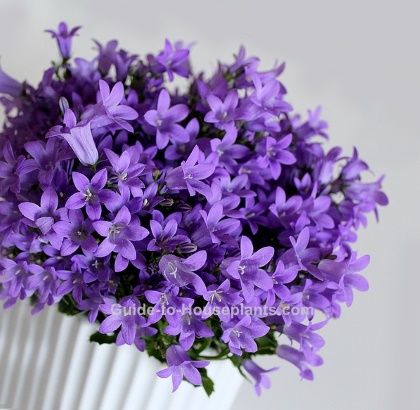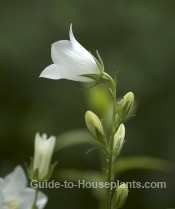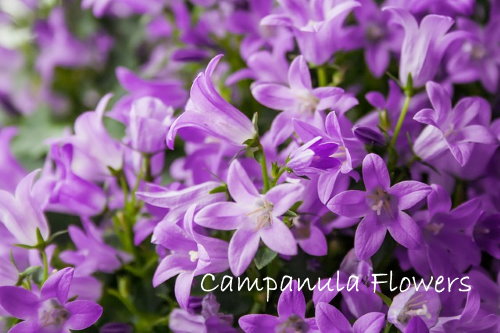Campanula Flowers Make Gorgeous Houseplants
Put Campanula flowers in a hanging basket or tall pot and allow its long stems studded with bell-shaped blooms to spill over the side of the container.
Known botanically as Campanula, this beauty makes a gorgeous houseplant. Here you’ll discover how much light it wants indoors, when to repot your plant, how to get the most blooms, and more.

Get to Know Campanula Flowers
This trailing form also goes by the common names Italian Bellflower and Falling Stars.
Its funnel-shaped flowers open to a 5-point starry shape, and are about 1 inch (2.5 cm) across.
Popular varieties include snowy white ‘Alba’ and ‘Stella White’… and violet blue ‘Mayi’ and ‘Stella Blue’.
Campanula is easy to grow indoors. It only demands cool air, moist soil and indirect sunlight. Treat it right and you can expect masses of these violet-blue flowers to bloom in mid-to-late summer right through fall.

Year-Round Care for Campanula Flowers
Overwinter your plant. It’s a perennial and will flower year after year. Cut stems back (close to the soil level of the plant) in late fall or early winter, after flowering season. It doesn’t need a cold season in winter. Give it the same temperature and light as usual. Keep the soil on the dry side until you see new growth in spring, then resume with normal watering.
To repot…or not. Repot campanula plants when their roots are visible at the surface of the soil. Wait till winter or early spring to repot — never while it’s blooming. Use a planter only 1-2 inches (2.5-5 cm) larger than the old one. Flowering plants bloom best when their roots are a little snug in the pot. If you want to use a decorative container that doesn’t have drainage holes, use it as a cachepot; just slip your plain nursery pot into the cachepot to cover it up.

Remove spent blooms. Cut off spent flower heads using scissors or pruning shears to avoid tearing the stems. By deadheading Campanula flowers, you’ll not only keep your plant looking its best, you’ll encourage more blooms.
Something bugging your plant? It may be aphids. These insects are attracted to new growth, such as young leaves and flower buds. If your plant is infested, treat it right away with an insecticide. Fungus gnats are another pest to watch for — they’re attracted to moist, peaty potting mixes.
Caring for Campanula Flowers

Origin: Northern Italy
Height: Up to 1 ft (30 cm)
Light: Bright indirect light. Some direct sun in winter is fine.
Water: Keep the soil moist, but not soggy while plant is growing and flowering. Soggy soil will cause root rot. After flowering, allow soil to become almost dry between waterings.
Humidity: Average indoor (around 40% relative humidity). High humidity can lead to gray mold on leaves. Cut off any affected areas and treat plant with a fungicide.
Temperature: Cool to average 45-65°F/7-18°C. Keep your Campanula plant away from doorways and air vents. Hot or cold drafts will cause dry, shriveled leaves and may cause flower buds to drop.
Soil: Any good-quality houseplant potting mix
Fertilizer: Feed every 2 weeks spring through fall with a water-soluble fertilizer diluted by half.
Propagation: Take stem tip cuttings in spring or early summer and root them in water or moist potting mix. Sow seeds in spring.




